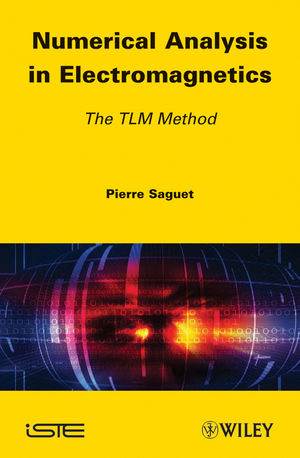
Numerical Analysis in Electromagnetics
ISTE Ltd and John Wiley & Sons Inc (Verlag)
978-1-84821-391-3 (ISBN)
- Titel z.Zt. nicht lieferbar
- Versandkostenfrei innerhalb Deutschlands
- Auch auf Rechnung
- Verfügbarkeit in der Filiale vor Ort prüfen
- Artikel merken
The aim of this book is to give a broad overview of the TLM (Transmission Line Matrix) method, which is one of the “time-domain numerical methods”. These methods are reputed for their significant reliance on computer resources. However, they have the advantage of being highly general.
The TLM method has acquired a reputation for being a powerful and effective tool by numerous teams and still benefits today from significant theoretical developments. In particular, in recent years, its ability to simulate various situations with excellent precision, including complex materials, has been demonstrated.
Application examples are included in the last two chapters of the book, enabling the reader to draw conclusions regarding the performance of the implemented techniques and, at the same time, to validate them.
Contents
1. Basis of the TLM Method: the 2D TLM Method.
2. 3D Nodes.
3. Introduction of Discrete Elements and Thin Wires in the TLM Method.
4. The TLM Method in Matrix Form and the Z Transform.
Appendix A. Development of Maxwell’s Equations using the Z Transform with a Variable Mesh.
Appendix B. Treatment of Plasma using the Z Transform for the TLM Method.
Pierre Saguet is Professor at the Ecole Nationale Supérieure d'Electronique de Grenoble, France, and manager of the electromagnetic modeling team in the IMEP-LAHC laboratory.
Introduction ix
Chapter 1. Basis of the TLM Method: the 2D TLM Method 1
1.1. Historical introduction 1
1.2. 2D simulation 5
1.2.1. Parallel node 5
1.2.2. Series node 8
1.2.3. Simulation of inhomogeneous media with losses 9
1.2.4. Scattering matrices 11
1.2.5. Boundary conditions 14
1.2.6. Dielectric interface passage conditions 15
1.2.7. Dispersion of 2D nodes. 17
1.3. The TLM process 22
1.3.1. Basic algorithm 22
1.3.2. Excitation 23
1.3.3. Output signal processing 24
Chapter 2. 3D Nodes 29
2.1. Historical development 29
2.1.1. Distributed nodes 29
2.1.2. Asymmetrical condensed node (ACN) 30
2.1.3. The symmetrical condensed node (SCN) 31
2.1.4. Other types of nodes 33
2.2. The generalized condensed node 37
2.2.1. General description 37
2.2.2. Derivation of 3D TLM nodes 41
2.2.3. Scattering matrices 46
2.3. Time step. 54
2.4. Dispersion of 3D nodes. 55
2.4.1. Theoretical study in simple cases 56
2.4.2. Case of inhomogeneous media. 60
2.5. Absorbing walls 60
2.5.1. Matched impedance 61
2.5.2. Segmentation techniques 62
2.5.3. Perfectly matched layers 62
2.5.4. Optimization of the PML layer profile 65
2.5.5. Anisotropic and dispersive layers 67
2.5.6. Conclusion 70
2.6. Orthogonal curvilinear mesh 70
2.6.1. 3D TLM curvilinear cell. 70
2.6.2. The TLM algorithm 73
2.6.3. Scattering matrices for curvilinear nodes 75
2.6.4. Stability conditions and the time step 78
2.6.5. Validation of the algorithm 79
2.7. Non-Cartesian nodes 81
Chapter 3. Introduction of Discrete Elements and Thin Wires in the TLM Method 85
3.1. Introduction of discrete elements 85
3.1.1. History of 2D TLM 85
3.1.2. 3D TLM 89
3.1.3. Application example: modeling of a p-n diode 100
3.2. Introduction of thin wires 105
3.2.1. Arbitrarily oriented thin wire model 106
3.2.2. Validation of the arbitrarily oriented thin wire model 119
Chapter 4. The TLM Method in Matrix Form and the Z Transform 123
4.1. Introduction 123
4.2. Matrix form of Maxwell’s equations 124
4.3. Cubic mesh normalized Maxwell’s equations 125
4.4. The propagation process 127
4.5. Wave-matter interaction 130
4.6. The normalized parallelepipedic mesh Maxwell's equations 133
4.7. Application example: plasma modeling 136
4.7.1. Theoretical model 136
4.7.2. Validation of the TLM simulation 139
4.8. Conclusion 144
APPENDICES 145
Appendix A. Development of Maxwell’s Equations using the Z Transform with a Variable Mesh 147
Appendix B. Treatment of Plasma using the Z Transform for the TLM Method 155
Bibliography 161
Index 171
| Verlagsort | London |
|---|---|
| Sprache | englisch |
| Maße | 161 x 241 mm |
| Gewicht | 463 g |
| Themenwelt | Naturwissenschaften ► Physik / Astronomie ► Elektrodynamik |
| Technik ► Elektrotechnik / Energietechnik | |
| ISBN-10 | 1-84821-391-3 / 1848213913 |
| ISBN-13 | 978-1-84821-391-3 / 9781848213913 |
| Zustand | Neuware |
| Haben Sie eine Frage zum Produkt? |
aus dem Bereich


